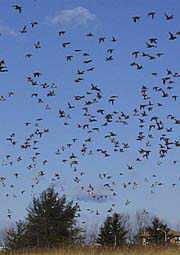“Just a few years ago,” said Hackensack Riverkeeper Bill Sheehan recently, “it was an exceedingly rare thing to see a bald eagle over the Hackensack River. Nowadays it’s almost a routine occurrence during the fall migration to see more than one between September and November, thanks in large measure to the Endangered Species Act.”
In order to better educate the public on the dramatic improvement of the Meadowlands environment, the New Jersey Meadowlands Commission will present a multi-media exhibit this month and in January. The exhibit, sponsored by the Conserve Wildlife Foundation of New Jersey and the New Jersey Department of Environmental Protection, will be on display at the Environmental center in Lyndhurst in celebration of the 30th year of the U.S. Endangered Species Act.
Sheehan said the Endangered Species Act, passed in 1973, sparked governmental and civic initiatives across the United States to preserve and protect that biodiversity of plants and animals that were considered in danger of vanishing.
The act covers two categories: species of plants and animals so rare as to become extinct, and those species that are declining rapidly.
Designed to be both entertaining and informative, the exhibit features an interactive collage of video, audio and graphics with a gallery of student art and panels that show how biologists, using innovated methods, work to protect rare wildlife.
Features include the “Wise up about Wildlife” trivia challenge.
The pride of the exhibit, however, is three rare animals preserved through taxidermy: a bald eagle, peregrine falcon and osprey, all of which make their home in the Meadowlands at some point during the changing seasons, but are rarely seen up close.
The peregrine falcon, according to Meadowlands environmentalist John Quinn, used to be abundant in North America, but due to shooting and contamination by the pesticide DDT, the bird went into a dramatic decline in the 1940s and 1950s. By the early 1970s, there were only an estimated 40 breeding pairs left in the contiguous 48 states.
“Although the peregrine falcon is not currently known to breed within the Meadowlands district, in 1994 there were 12 pairs known to live within a 15 mile radius of the region,” Quinn wrote his book Fields of Sun and Grass, an Artist’s Journal of the New Jersey Meadowlands. He said that in the late 1990s, a pair nested in the Kearny PSE&G power plant.
“We’re excited about hosting this exhibit,” said Robert Ceberio, NJMC executive director. “When people come here in the next two months, we hope they will be captivated by the wildlife species that we are in danger of losing, and will show their support for the efforts of the commission to preserve this very unique urban wilderness.”
A public reception will be held at the Environmental Center on Saturday, Dec. 13 from 12:30 to 2:30 p.m. Speakers will include Ceberio, Sheehan, and Martin McHugh of the NJ Department of Environmental Protection.
In addition to the Endangered Wildlife Exhibit, NJMC is offering two other programs on endangered species in December: On Saturday, Dec. 6 at 11 a.m., the commission planned to present a program called Wild Safari, featuring wildlife expert Andres Simmons to talk about once-endangered species. He was likely to bring along his golden eagle, alligator, black bear cub and other animals.
On Saturday, Dec. 13 at 11 a.m., the Environmental Center will host a program called “Animals on the Brink,” in which Bill Boesenberg, a licensed reptile and amphibian rehabilitator, will have a variety of animals includes lizard, turtle, snakes and others, and he will talk about how animals can be affected by sudden changes to their environment and how these changes can sometimes lead to extinction. These two programs are for adults and children. Each costs $5. For more information, call Gabrielle Bennett-Meany at (201) 460-4640.
